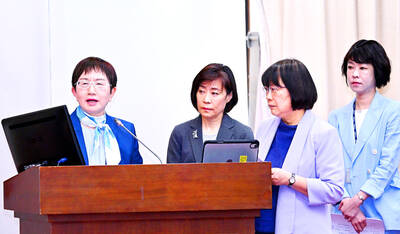The IMF on Tuesday raised its forecast for Taiwan’s GDP growth for this year to 3.3 percent, up 0.1 percentage points from its April estimate.
In its October World Economic Outlook report, the IMF said that the global economy is experiencing turbulent challenges shaped by the lingering effects of Russia’s invasion of Ukraine and tightening financial conditions in most regions.
In addition, the highest inflation in several decades and the lingering effects of the COVID-19 pandemic weigh heavily on the outlook, the report said.

Photo: Carlos Garcia Rawlins, Reuters
As a result, it forecast global growth to slow from 6 percent last year to 3.2 percent this year and 2.7 percent next year, the report said.
Global inflation is expected to rise from 4.7 percent last year to 8.8 percent this year, but fall to 6.5 percent next year and 4.1 percent by 2024, it said.
Although the IMF raised its forecast for Taiwan’s GDP growth this year, it cut its growth projection for the economy next year to 2.8 percent, down 0.1 percentage points from its April estimate.
As for inflation, the IMF projected that Taiwan’s consumer price index (CPI) would rise 3.1 percent this year and 2.2 percent next year, lower than global levels, while the nation’s unemployment rate is forecast to be 3.6 percent this year and next year.
Of the major economies in Asia, China’s GDP growth is expected to slow from 8.1 percent last year to 3.2 percent this year and 4.4 percent next year, while its CPI is forecast to rise 2.2 percent this year and next.
Japan’s GDP is expected to grow 1.7 percent this year and 1.6 percent next year, while its CPI is forecast to increase 2 percent this year and 1.4 percent next year.
South Korea’s economy is forecast to grow 2.6 percent this year and 2 percent next year, while its CPI is to increase 5.5 percent this year and 3.8 percent next year, the report said.
The IMF also forecast that Singapore’s GDP would grow 3 percent this year and 2.3 percent next year, while Hong Kong’s economy is expected to see negative growth of minus-0.8 percent this year and growth of 3.9 percent next year.

‘SWASTICAR’: Tesla CEO Elon Musk’s close association with Donald Trump has prompted opponents to brand him a ‘Nazi’ and resulted in a dramatic drop in sales Demonstrators descended on Tesla Inc dealerships across the US, and in Europe and Canada on Saturday to protest company chief Elon Musk, who has amassed extraordinary power as a top adviser to US President Donald Trump. Waving signs with messages such as “Musk is stealing our money” and “Reclaim our country,” the protests largely took place peacefully following fiery episodes of vandalism on Tesla vehicles, dealerships and other facilities in recent weeks that US officials have denounced as terrorism. Hundreds rallied on Saturday outside the Tesla dealership in Manhattan. Some blasted Musk, the world’s richest man, while others demanded the shuttering of his

ADVERSARIES: The new list includes 11 entities in China and one in Taiwan, which is a local branch of Chinese cloud computing firm Inspur Group The US added dozens of entities to a trade blacklist on Tuesday, the US Department of Commerce said, in part to disrupt Beijing’s artificial intelligence (AI) and advanced computing capabilities. The action affects 80 entities from countries including China, the United Arab Emirates and Iran, with the commerce department citing their “activities contrary to US national security and foreign policy.” Those added to the “entity list” are restricted from obtaining US items and technologies without government authorization. “We will not allow adversaries to exploit American technology to bolster their own militaries and threaten American lives,” US Secretary of Commerce Howard Lutnick said. The entities

Minister of Finance Chuang Tsui-yun (莊翠雲) yesterday told lawmakers that she “would not speculate,” but a “response plan” has been prepared in case Taiwan is targeted by US President Donald Trump’s reciprocal tariffs, which are to be announced on Wednesday next week. The Trump administration, including US Secretary of the Treasury Scott Bessent, has said that much of the proposed reciprocal tariffs would focus on the 15 countries that have the highest trade surpluses with the US. Bessent has referred to those countries as the “dirty 15,” but has not named them. Last year, Taiwan’s US$73.9 billion trade surplus with the US

Prices of gasoline and diesel products at domestic gas stations are to fall NT$0.2 and NT$0.1 per liter respectively this week, even though international crude oil prices rose last week, CPC Corp, Taiwan (台灣中油) and Formosa Petrochemical Corp (台塑石化) said yesterday. International crude oil prices continued rising last week, as the US Energy Information Administration reported a larger-than-expected drop in US commercial crude oil inventories, CPC said in a statement. Based on the company’s floating oil price formula, the cost of crude oil rose 2.38 percent last week from a week earlier, it said. News that US President Donald Trump plans a “secondary